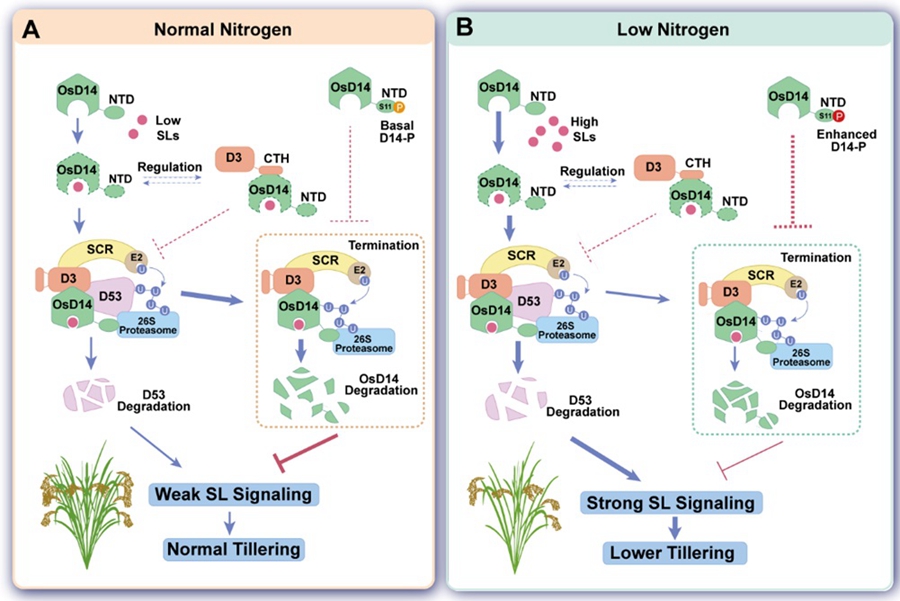“How is plant growth controlled” and “What is the basis of variation in stress tolerance in plants” are among the 125 most challenging scientific questions published by Science.
Strigolactone (SL) is an important plant hormone that plays essential roles in regulating branch number, a key growth and development trait for plants. Recently, WANG Bing et al. from the team led by Prof. LI Jiayang at the Institute of Genetics and Developmental Biology (IGDB), Chinese Academy of Sciences (CAS), have discovered the mechanism of SL perception and its key role in tillering response to nitrogen. The “gas and brake” mechanism of SL perception allows “smart and flexible” regulation on the duration and intensity of SL signaling, thereby regulating rice tiller development in response to nitrogen.
The study was published online in the top-tier international journal, Cell, on November 4, 2024 (DOI: 10.1016/j.cell.2024.10.009).
In the field of SL signaling, studies over the past 15 years revealed that DWARF14 (D14) and its homologs are SL receptors that from protein complexes with D3 and D53. However, the SL perception mechanisms remain challenging and controversial.
To elucidate the key mechanism of SL perception, WANG et al. systematically identified the D14 amino acid residues vital for interactions with D3 and D53 and revealed the mechanism underlying activation of SL perception.
They further explored the termination mechanism of SL perception. Through ingenious experimental design, they reported that the ubiquitination and protein degradation of D14 were dependent on D3 and required the D14 N-terminal disordered (NTD) domain, representing an undiscovered mechanism in higher plants.
As a subunit of the E3 ligase that recognizes substrates, D3 first promotes the ubiquitination and degradation of D53 to initiate signal transduction and then promotes the ubiquitination and degradation of D14 to terminate signal sensing. This constitutes a pair of “gas pedal” and “brakes” in signal transduction.
More interestingly, the NTD domain of D14 undergoes phosphorylation to inhibit ubiquitination and degradation of D14, thereby regulating tiller development in rice. The low-nitrogen environment increased the phosphorylation of D14, thereby inhibiting protein degradation and enhancing SL perception. Genetic analysis further confirmed that the phosphorylation of D14 at the N-terminus was an important mechanism in the regulation of rice tillering by low-nitrogen signals.
Finally, they proposed that the low-nitrogen signal, on the one hand, enhances SL perception by inducing SL biosynthesis and, on the other hand, inhibits D14 degradation by promoting its own phosphorylation, thereby reducing termination of SL perception. These mechanisms synergistically enhance the function of the SL pathway to reduce tiller number.
By changing the phosphorylation status of D14, a reduction in nitrogen fertilizer input without a reduction in tillering can be realized, which is important for guiding the precise improvement of crop architecture and the molecular design of crops with higher yields and less fertilizer needs.
All three reviewers give highly positive comments on the study, pointing out that “The experiments are sound and highly sophisticated, and the conclusions in each part are clear and convincing”; “The results reported in this manuscript are original and novel”; “ This study reveals exciting novelties, for instance with respect to a post-translational modification (phosphorylation) of D14 and its role in the response to nitrogen availability”; “Their findings provide a new view of how SL perception is regulated and address some controversial points on the variety of different models in SL perception”.
This study was supported by the National Key R&D Program, the National Natural Science Foundation of China, the Basic Research Young Scientist Project of the CAS, and the Youth Promotion Association of the CAS.
Contact:
Dr. WANG Bing
Institute of Genetics and Developmental Biology, Chinese Academy of Sciences
bingwang@genetics.ac.cn
 CAS
CAS
 中文
中文




.png)

